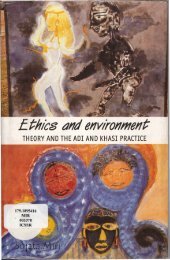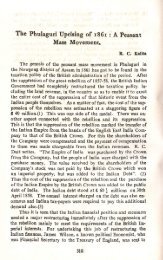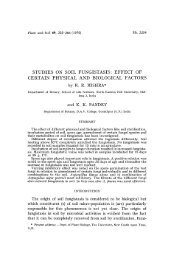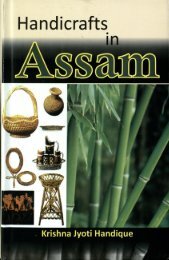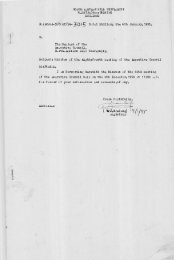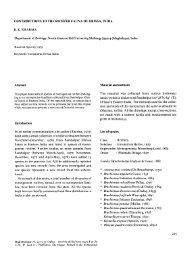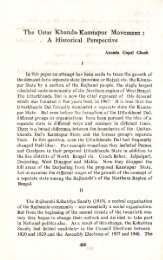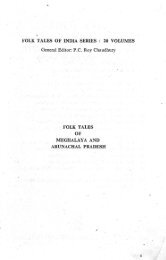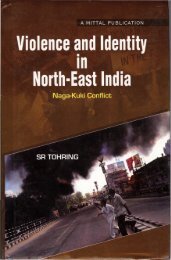Leaf litter decomposition and nutrient mineralization patterns in ...
Leaf litter decomposition and nutrient mineralization patterns in ...
Leaf litter decomposition and nutrient mineralization patterns in ...
You also want an ePaper? Increase the reach of your titles
YUMPU automatically turns print PDFs into web optimized ePapers that Google loves.
<strong>Leaf</strong> <strong>litter</strong> <strong>decomposition</strong> <strong>and</strong> <strong>nutrient</strong> <strong>m<strong>in</strong>eralization</strong> <strong>patterns</strong> <strong>in</strong><br />
regrow<strong>in</strong>g st<strong>and</strong>s of a humid subtropical forest after tree cutt<strong>in</strong>g<br />
A. Arunachalam a,* , Kusum Maithani a , H.N. P<strong>and</strong>ey b , R.S. Tripathi b<br />
a Restoration Ecology Laboratory, Department of Forestry, North Eastern Regional Institute of Science <strong>and</strong> Technology, Nirjuli-791109, India<br />
b Plant Ecology Laboratory, Department of Botany, North-Eastern Hill University, Shillong-793022, India<br />
Abstract<br />
Accepted 16 December 1997<br />
Decomposition dynamics, <strong>and</strong> N <strong>and</strong> P <strong>m<strong>in</strong>eralization</strong> <strong>patterns</strong> of leaf <strong>litter</strong> of P<strong>in</strong>us kesiya, Quercus dealbata, Q. grif®thii,<br />
Rhododendron arboreum <strong>and</strong> Schima khasiana were studied <strong>in</strong> forest of three different ages <strong>in</strong> a humid subtropical region of<br />
India. The decay pattern varied from species to species. The decay pattern, characterized us<strong>in</strong>g a composite l<strong>in</strong>ear regression<br />
equations, exhibited two to three dist<strong>in</strong>ct phases dur<strong>in</strong>g leaf <strong>litter</strong> <strong>decomposition</strong>. Initial lign<strong>in</strong>, nitrogen (N) <strong>and</strong> lign<strong>in</strong>/N<br />
showed signi®cant negative correlations with decay rate, whereas soil properties like pH, moisture <strong>and</strong> total Kjeldahl nitrogen<br />
(TKN) <strong>and</strong> climatic variables, e.g. ra<strong>in</strong>fall <strong>and</strong> air temperature, showed positive correlations. The annual dry matter decay<br />
constants (k) varied from 0.77 <strong>in</strong> R. arboreum to 1.39 <strong>in</strong> Q. grif®thii. Nutrient release from the decompos<strong>in</strong>g <strong>litter</strong> was<br />
<strong>in</strong>¯uenced by the seasonal cycle of <strong>m<strong>in</strong>eralization</strong> <strong>and</strong> immobilization processes. Net <strong>m<strong>in</strong>eralization</strong> was rapid dur<strong>in</strong>g ra<strong>in</strong>y<br />
season, as nitrogen (N) <strong>and</strong> phosphorus (P) concentrations <strong>in</strong> the decompos<strong>in</strong>g leaf <strong>litter</strong> decreased by ca. 20±50% from the<br />
preced<strong>in</strong>g season, while immobilization occurred dur<strong>in</strong>g w<strong>in</strong>ter when <strong>nutrient</strong> concentration <strong>in</strong>creased up to 60%. Annual dry<br />
matter decay, net N <strong>and</strong> P <strong>m<strong>in</strong>eralization</strong> constants for Q. dealbata were higher <strong>in</strong> the 16-year old regrowth than <strong>in</strong> the 13-year<br />
old regrowth. # 1998 Elsevier Science B.V.<br />
Keywords: Litter decay; Nitrogen; Phosphorus; Humid subtropics<br />
1. Introduction<br />
Litter <strong>decomposition</strong> plays a crucial role <strong>in</strong> the<br />
<strong>nutrient</strong> budget of the tropical forest ecosystems<br />
where vegetation depends ma<strong>in</strong>ly on the recycl<strong>in</strong>g<br />
of <strong>nutrient</strong>s conta<strong>in</strong>ed <strong>in</strong> the plant detritus (Vogt et<br />
al., 1986). The <strong>decomposition</strong> rate is strongly <strong>in</strong>¯uenced<br />
by climatic conditions <strong>and</strong> <strong>in</strong>itial chemical<br />
composition of the <strong>litter</strong> (Couteaux et al., 1995).<br />
*Correspond<strong>in</strong>g author.<br />
Forest Ecology <strong>and</strong> Management 109 (1998) 151Ð161<br />
0378-1127/98/$19.00 # 1998 Elsevier Science B.V. All rights reserved.<br />
PII S0378-1127(98)00240-0<br />
Among the climatic variables, ra<strong>in</strong>fall <strong>and</strong> air temperature<br />
determ<strong>in</strong>e the rate of <strong>decomposition</strong> <strong>in</strong> areas<br />
subjected to unfavourable weather conditions. Nitrogen<br />
(N) <strong>and</strong> lign<strong>in</strong> have been reported to have a better<br />
control over the <strong>litter</strong> decay rate <strong>in</strong> the humid tropics<br />
than <strong>in</strong> the temperate zones (Swift et al., 1979). A<br />
strong negative l<strong>in</strong>ear relationship between <strong>in</strong>itial<br />
lign<strong>in</strong>/N ratio <strong>and</strong> disappearance rate of leaf <strong>litter</strong><br />
was reported by Melillo et al. (1982). Lee (1974)<br />
has emphasized the relative importance of soil micro<strong>and</strong><br />
macrofauna <strong>in</strong> <strong>litter</strong> <strong>decomposition</strong>. Horward <strong>and</strong>
152 A. Arunachalam et al. / Forest Ecology <strong>and</strong> Management 109 (1998) 151±161<br />
Table 1<br />
Dom<strong>in</strong>ant tree species <strong>and</strong> characteristics of the top soil (0±10 cm) layer <strong>in</strong> the three forest regrowths<br />
Age of forest regrowth Dom<strong>in</strong>ant tree species Soil characteristics<br />
SMC a (%) pH SOM b (%) TKN c (%) Available P (mgg 1 )<br />
7-year P. kesiya 30.33 5.15 6.56 0.35 7.64<br />
13-year Q. dealbata 6.10 4.72 8.67 0.49 11.94<br />
16-year Q. dealbata 43.86 4.44 10.88 0.61 11.23<br />
a Soil moisture content.<br />
b Soil organic matter.<br />
c Total Kjeldahl nitrogen.<br />
Horward (1980) <strong>and</strong> Van Vuuren et al. (1993) have<br />
emphasized that tree <strong>and</strong> shrub leaf <strong>litter</strong> <strong>decomposition</strong><br />
varies depend<strong>in</strong>g on species <strong>and</strong> type of soil. The<br />
role of N availability on <strong>litter</strong> <strong>decomposition</strong> <strong>in</strong> forests<br />
has been discussed by Prescott (1995). This paper<br />
presents the ®nd<strong>in</strong>gs of a study on the effects of <strong>in</strong>itial<br />
<strong>litter</strong> chemistry <strong>and</strong> soil conditions on the <strong>litter</strong> <strong>decomposition</strong><br />
<strong>and</strong> <strong>nutrient</strong> <strong>m<strong>in</strong>eralization</strong> <strong>patterns</strong> of major<br />
tree species <strong>in</strong> three different-aged forest st<strong>and</strong>s recover<strong>in</strong>g<br />
after selective tree cutt<strong>in</strong>g <strong>in</strong> a subtropical<br />
humid forest of northeastern India.<br />
2. Study area<br />
Disturbed forest st<strong>and</strong>s of three different ages (7-,<br />
13- <strong>and</strong> 16-year old) located near Shillong (latitude<br />
25834 0 N, longitude 91856 0 E, altitude 1900 m a.s.l.)<br />
were selected for the present study. As the st<strong>and</strong>s<br />
were selectively cut, a few older trees (DBH 10±<br />
40 cm) were found <strong>in</strong>terspersed <strong>in</strong> the st<strong>and</strong>s. All<br />
st<strong>and</strong>s were located on a gentle hill slope (6±138S)<br />
<strong>and</strong> covered an area of ca. 1 ha each. The area is highly<br />
monsoonal (average annual ra<strong>in</strong>fall 1547 mm) with<br />
w<strong>in</strong>ter, spr<strong>in</strong>g, ra<strong>in</strong>y <strong>and</strong> autumn seasons. A total of<br />
80% of the annual ra<strong>in</strong> was con®ned to the ra<strong>in</strong>y<br />
season. Mean annual air temperature dur<strong>in</strong>g the study<br />
period was 258C. Detailed account of climate, soil <strong>and</strong><br />
vegetation of the study sites has been given <strong>in</strong> Arunachalam<br />
(1997), Arunachalam et al. (1996a, b). The<br />
7-year old st<strong>and</strong> is dom<strong>in</strong>ated by young trees of P<strong>in</strong>us<br />
kesiya with resprout<strong>in</strong>g from stumps of broadleaved<br />
trees of Quercus dealbata <strong>and</strong> Schima khasiana. The<br />
density of woody vegetation was 680 stems ha 1 <strong>in</strong><br />
the 7-year old st<strong>and</strong>, 1260 stems ha 1 <strong>in</strong> 13-year old<br />
st<strong>and</strong> <strong>and</strong> 1440 stems ha 1 <strong>in</strong> the 16-year old st<strong>and</strong>.<br />
The correspond<strong>in</strong>g basal areas were 3.1, 19.9,<br />
44.2 m 2 ha 1 <strong>in</strong> the 7-, 13- <strong>and</strong> 16-year old st<strong>and</strong>s,<br />
respectively. The soil (latosol±oxisol) is derived from<br />
Precambrian igneous rocks. The m<strong>in</strong>eral soil (0±<br />
10 cm depth) was s<strong>and</strong>y loam <strong>in</strong> the 7-year old st<strong>and</strong>,<br />
s<strong>and</strong>y clay to clay loam <strong>in</strong> the 13-year old st<strong>and</strong> <strong>and</strong><br />
clay loam <strong>in</strong> the 16-year old st<strong>and</strong>. The water hold<strong>in</strong>g<br />
capacity (WHC), soil organic matter (SOM), total<br />
Kjeldahl nitrogen (TKN) <strong>and</strong> available P <strong>in</strong> the soil<br />
<strong>in</strong>creased gradually from the 7- to 16-year old st<strong>and</strong>s<br />
(Table 1).<br />
3. Methods<br />
3.1. <strong>Leaf</strong>-<strong>litter</strong> chemistry<br />
Freshly fallen needles/leaves of dom<strong>in</strong>ant tree species<br />
recorded <strong>in</strong> 1993 vegetation survey <strong>in</strong> the three<br />
forest st<strong>and</strong> were collected dur<strong>in</strong>g peak <strong>litter</strong>fall period<br />
(March): P. kesiya (7-year old st<strong>and</strong>); Q. dealbata<br />
(13-year old st<strong>and</strong>); Q. grif®thii, Rhododendron arboreum<br />
<strong>and</strong> S. khasiana (16-year old st<strong>and</strong>). Leaves of Q.<br />
dealbata collected from the 13-year old st<strong>and</strong> were<br />
also used <strong>in</strong> the 16-year old st<strong>and</strong>. The <strong>litter</strong> samples<br />
were air-dried <strong>in</strong> the laboratory <strong>and</strong> sub-samples were<br />
kept at 808C for 48 h for determ<strong>in</strong><strong>in</strong>g the dry mass.<br />
The oven-dried materials were powdered <strong>in</strong> a Cyclotec<br />
(TECATOR) <strong>and</strong> analyzed for their chemical composition.<br />
The ash content was determ<strong>in</strong>ed by ignit<strong>in</strong>g 1 g<br />
of ground <strong>litter</strong> sample at 5508C for 6 h <strong>in</strong> a muf¯e<br />
furnace. A total of 50% of the ash-free mass was<br />
calculated as the carbon (C) content. Nitrogen (N) was<br />
estimated follow<strong>in</strong>g semimicro-Kjeldahl method <strong>in</strong> a<br />
Kjeltec Auto 1030 Analyzer (TECATOR). Total phosphorus<br />
(P) was analyzed colorimetrically while lign<strong>in</strong>
<strong>and</strong> cellulose contents were measured gravimetrically<br />
(Anderson <strong>and</strong> Ingram, 1993).<br />
3.2. Litter <strong>decomposition</strong><br />
Decomposition of leaf <strong>litter</strong> of dom<strong>in</strong>ant tree species<br />
was studied <strong>in</strong> their respective st<strong>and</strong>s us<strong>in</strong>g the<br />
nylon mesh (20 20 cm) bag technique (Gilbert <strong>and</strong><br />
Bocock, 1960). The mesh size was 2 mm, small<br />
enough to prevent major losses of needles or leaves,<br />
yet large enough to permit aerobic microbial activity<br />
<strong>and</strong> free entry of small soil animals. However, it<br />
excludes larger arthropods <strong>and</strong> earthworms, which<br />
are important primary accessors of <strong>litter</strong> <strong>and</strong>, presumably,<br />
it becomes a <strong>litter</strong> system dom<strong>in</strong>ated by termites,<br />
bacteria, fungi <strong>and</strong> act<strong>in</strong>omycetes. Consequently,<br />
there could be an underestimation of <strong>litter</strong> <strong>decomposition</strong><br />
rates. For the experiment, 10 g of the air-dried<br />
material was kept <strong>in</strong> each bag which was then stitched<br />
with nylon threads. For each species, 60 bags were<br />
prepared <strong>and</strong> r<strong>and</strong>omly dispersed on the forest ¯oor <strong>in</strong><br />
the respective st<strong>and</strong>s <strong>in</strong> the month of May 1993. After<br />
60, 120, 180, 240, 300, 360, 420, 480, 540 <strong>and</strong> 600<br />
days, ®ve <strong>litter</strong> bags for each species were brought to<br />
the laboratory carefully avoid<strong>in</strong>g loss of material from<br />
the <strong>litter</strong> bags. The <strong>litter</strong> was washed <strong>in</strong> a bucket full of<br />
tap water by swirl<strong>in</strong>g brie¯y <strong>and</strong> carefully decant<strong>in</strong>g<br />
through 2-mm mesh sieve to remove extraneous<br />
matter. Accord<strong>in</strong>g to Anderson <strong>and</strong> Ingram (1993),<br />
such brief wash<strong>in</strong>g permits little leach<strong>in</strong>g. The <strong>litter</strong><br />
was then dried at 808C for 48 h <strong>and</strong> weighed. The<br />
samples were powdered <strong>and</strong> used for the analysis<br />
of N <strong>and</strong> P contents accord<strong>in</strong>g to semimicro-Kjeldahl<br />
<strong>and</strong> colorimetric procedures given <strong>in</strong> Anderson <strong>and</strong><br />
Ingram (1993).<br />
3.3. Computation<br />
A. Arunachalam et al. / Forest Ecology <strong>and</strong> Management 109 (1998) 151±161 153<br />
Organic matter decay, <strong>and</strong> N <strong>and</strong> P <strong>m<strong>in</strong>eralization</strong><br />
constants for leaf <strong>litter</strong> were computed us<strong>in</strong>g negative<br />
exponential decay model of Olson (1963): X/X 0ˆ<br />
exp( kt), where X is the weight rema<strong>in</strong><strong>in</strong>g at time<br />
t, X0 the <strong>in</strong>itial weight, exp the base of natural<br />
logarithm, k the decay rate coef®cient <strong>and</strong> t the time<br />
(year). N <strong>and</strong> P <strong>m<strong>in</strong>eralization</strong> constants (kN <strong>and</strong> kP)<br />
were calculated by substitut<strong>in</strong>g dry weight with N <strong>and</strong><br />
P contents <strong>in</strong> the forego<strong>in</strong>g formula (S<strong>in</strong>gh <strong>and</strong> Shekhar,<br />
1989). Further, the time required for 50% (t50)<br />
<strong>and</strong> 99% (t 99) decay were calculated as t50ˆ0.693/k<br />
<strong>and</strong> t99ˆ5/k.<br />
3.4. Statistical analysis<br />
In order to dist<strong>in</strong>guish between different phases of<br />
weight-loss pattern dur<strong>in</strong>g <strong>decomposition</strong>, multiple<br />
regressions were developed us<strong>in</strong>g dummy factors (0<br />
or 1) as the <strong>in</strong>dicator variables (Zar, 1974). The<br />
composite l<strong>in</strong>ear-regression model (Arunachalam et<br />
al., 1996b) used for this purpose was Yˆa‡bX1‡<br />
cX2‡dX3..., where Y is the percentage of <strong>in</strong>itial mass<br />
rema<strong>in</strong><strong>in</strong>g, a the Y <strong>in</strong>tercept, b the rate of change<br />
<strong>in</strong> Y with respect to time, c the shift parameter for<br />
adjustment of the Y <strong>in</strong>tercept <strong>in</strong> phase-II <strong>and</strong> d the<br />
shift parameter for adjustment of the Y <strong>in</strong>tercept <strong>in</strong><br />
phase-III. The values of c <strong>and</strong> d were taken as zero,<br />
if decay was slow, <strong>and</strong>/or equal to one, if the decay<br />
was rapid.<br />
The effect of climatic variables, <strong>in</strong>itial <strong>litter</strong> chemistry<br />
<strong>and</strong> a few soil characteristics on the <strong>decomposition</strong><br />
rate of leaf <strong>litter</strong> was assessed us<strong>in</strong>g simple l<strong>in</strong>earregression<br />
function, Yˆa‡bX. As the type <strong>and</strong> number<br />
of species used for <strong>decomposition</strong> study <strong>in</strong> the three<br />
st<strong>and</strong>s were different, there were chances of pseudoreplication<br />
<strong>in</strong> the application of analysis of variance<br />
(ANOVA, ®xed-effects model). To overcome the problem,<br />
the ANOVA was used to test the signi®cance of<br />
differences <strong>in</strong> the <strong>decomposition</strong> rate due to sampl<strong>in</strong>g<br />
time for each species <strong>in</strong> the three st<strong>and</strong>s <strong>and</strong> among the<br />
species <strong>in</strong> the 16-year old st<strong>and</strong> only. However, comparison<br />
between plots were done by regression.<br />
4. Results<br />
4.1. Initial chemistry of leaf <strong>litter</strong><br />
Mean N concentration <strong>in</strong> the leaf <strong>litter</strong> of ®ve<br />
dom<strong>in</strong>ant species varied from a m<strong>in</strong>imum of 0.59%<br />
<strong>in</strong> R. arboreum to a maximum of 1.03% <strong>in</strong> S. khasiana.<br />
Phosphorus concentration was relatively low, vary<strong>in</strong>g<br />
between 0.03±0.06% <strong>in</strong> different species. Lign<strong>in</strong> concentration<br />
was maximum (43.2%) <strong>in</strong> the coniferous<br />
species, P. kesiya. Among the broadleaved species, R.<br />
arboreum had the highest concentration of lign<strong>in</strong><br />
(37.3%). In other species lign<strong>in</strong> concentration varied<br />
from 23.7±25.1%. Cellulose concentration was much
154 A. Arunachalam et al. / Forest Ecology <strong>and</strong> Management 109 (1998) 151±161<br />
Table 2<br />
Chemical composition of leaf <strong>litter</strong> of dom<strong>in</strong>ant tree species used for <strong>decomposition</strong> study by the <strong>litter</strong>-bag method ( SEM (nˆ5))<br />
Species C (%) N (%) P (%) Lign<strong>in</strong> (%) Cellulose (%) C/N Lign<strong>in</strong>/N<br />
P. kesiya 47.3 1.2 0.98 0.01 0.05 0.004 43.2 1.1 7.4 0.9 48.27 44.08<br />
Q. dealbata 47.6 0.3 0.89 0.01 0.06 0.01 24.4 1.4 7.1 1.9 53.48 27.42<br />
Q. griffithii 46.4 2.1 0.73 0.05 0.05 0.001 23.7 0.9 11.9 0.3 63.56 32.47<br />
R. arboreum 45.6 3.6 0.59 0.06 0.03 0.001 37.3 9.3 0.7 77.29 63.22 3.1<br />
S. khasiana 47.3 1.0 1.03 0.03 0.04 0.001 25.1 3.1 5.1 0.1 45.92 24.37<br />
higher (11.9%) <strong>in</strong> Q. grif®thii than <strong>in</strong> R. arboreum<br />
(9.3%) <strong>and</strong> other species (5.1±7.4%). Lign<strong>in</strong> <strong>and</strong><br />
cellulose concentrations were m<strong>in</strong>imum <strong>in</strong> Q. grif®thii<br />
<strong>and</strong> S. khasiana, respectively (Table 2).<br />
4.2. Weight-loss pattern<br />
Needles of P. kesiya decomposed <strong>in</strong> a three-phased<br />
manner (Fig. 1(a)). The ®rst phase lasted for ca. 60<br />
Fig. 1. Decay pattern of leaf <strong>litter</strong> of different species <strong>in</strong> the regrow<strong>in</strong>g forest communities. (&), Observed values, <strong>and</strong> the curve has been<br />
fitted us<strong>in</strong>g expected values calculated by the composite l<strong>in</strong>ear-regression equation. (a), P. kesiya (7-year old st<strong>and</strong>), (b), Q. dealbata (13-year<br />
old st<strong>and</strong>), (c), Q. dealbata (16-year-old st<strong>and</strong>), (d), Q. griffithii (16-year old st<strong>and</strong>), (e), R. arboreum (16-year old st<strong>and</strong>) <strong>and</strong> (f), S. khasiana<br />
(16-year old st<strong>and</strong>).
days <strong>and</strong> was characterized by a slow rate (0.05% wtloss<br />
day 1 ) of decay. This was followed by a period of<br />
rapid weight loss (0.75% wt-loss day 1 ) for up to 120<br />
days (Table 3). Dur<strong>in</strong>g the third phase (i.e. 120±600<br />
days), decay cont<strong>in</strong>ued more-or-less at a constant rate<br />
(0.08% wt-loss day 1 ). Q. dealbata, Q. grif®thii <strong>and</strong> S.<br />
khasiana followed a two-phased decay pattern<br />
(Fig. 1(b±d) <strong>and</strong> (f)). The ®rst phase last<strong>in</strong>g for about<br />
120 days, was characterized by a rapid weight loss,<br />
followed by a slow rate of decay until 600 days<br />
(Table 3). Leaves of R. arboreum followed a uniform<br />
pattern of weight loss from the beg<strong>in</strong>n<strong>in</strong>g to the end of<br />
the experiment (Fig. 1(e)).<br />
A composite l<strong>in</strong>ear regression model,<br />
Yˆa‡bX 1‡cX 2‡dX 3 showed a good ®t for the<br />
weight-loss pattern <strong>in</strong> P. kesiya. The multiple regression<br />
equation, Yˆa‡bX1‡cX2 ®tted well for the<br />
observed decay pattern of all broadleaved species<br />
except for R. arboreum, where a simple l<strong>in</strong>ear-regression<br />
function, Yˆa‡bX was the best ®t. The correlation<br />
coef®cients describ<strong>in</strong>g the decay rates over time<br />
were highly signi®cant (P
156 A. Arunachalam et al. / Forest Ecology <strong>and</strong> Management 109 (1998) 151±161<br />
Table 4<br />
Annual decay <strong>and</strong> <strong>m<strong>in</strong>eralization</strong> constants of leaf <strong>litter</strong> of the studied species <strong>in</strong> three forest regrowths<br />
Decay/<strong>m<strong>in</strong>eralization</strong> P. kesiya a<br />
Q. dealbata b<br />
Phosphorus <strong>m<strong>in</strong>eralization</strong> constant for R. arboreum<br />
was m<strong>in</strong>imum (k Pˆ0.37). In other species, it varied<br />
between 0.80 <strong>and</strong> 1.28 (Table 4). Despite variations <strong>in</strong><br />
Q. dealbata c<br />
Q. griffithii c<br />
R. arboreum c<br />
Dry mass<br />
k d<br />
1.28 0.88 1.24 1.39 0.77 1.06<br />
e<br />
t50 0.50 0.80 0.60 0.50 0.90 0.70<br />
t99 f<br />
Nitrogen<br />
3.90 5.70 4.00 3.60 6.50 4.70<br />
kN 1.24 0.69 1.24 1.28 0.62 1.02<br />
t50 0.60 1.00 0.60 0.54 1.12 0.71<br />
t99<br />
Phosphorus<br />
4.00 7.20 4.00 3.90 8.10 4.90<br />
kP 1.20 0.80 1.13 1.28 0.37 0.92<br />
t50 0.56 0.90 0.61 0.54 1.90 0.76<br />
t99 4.20 6.23 4.42 3.91 13.70 5.48<br />
a In 7-year-old regrowth.<br />
b In 13-year-old regrowth.<br />
c In 16-year-old regrowth.<br />
d The decay constant.<br />
e N <strong>m<strong>in</strong>eralization</strong> constant.<br />
f P <strong>m<strong>in</strong>eralization</strong> constant.<br />
S. khasiana c<br />
kN <strong>and</strong> kP, N <strong>and</strong> P stocks <strong>in</strong> decompos<strong>in</strong>g leaf <strong>litter</strong><br />
were positively correlated (P
5. Discussion<br />
5.1. Resource quality<br />
A. Arunachalam et al. / Forest Ecology <strong>and</strong> Management 109 (1998) 151±161 157<br />
Fig. 2. N (A) <strong>and</strong> P (B) concentrations (%) <strong>in</strong> the decompos<strong>in</strong>g leaf<br />
<strong>litter</strong> through time. (-*-), P. kesiya; (-*-), Q. dealbata (13-yearold<br />
regrowth); (-~-), Q. dealbata (16-year-old regrowth); (-~-),<br />
Q. griffithii; (-&-), R. arboreum; <strong>and</strong> (-&-), S. khasiana. Vertical<br />
bars <strong>in</strong>dicate LSD at P
158 A. Arunachalam et al. / Forest Ecology <strong>and</strong> Management 109 (1998) 151±161<br />
Fig. 3. Net N <strong>m<strong>in</strong>eralization</strong> rate (% release day 1 ) <strong>in</strong> the decompos<strong>in</strong>g leaf <strong>litter</strong> of the studied species dur<strong>in</strong>g different seasons (R ± ra<strong>in</strong>y, A<br />
± autumn, W ± w<strong>in</strong>ter <strong>and</strong> S ± spr<strong>in</strong>g seasons).<br />
greater lign<strong>in</strong> <strong>in</strong> the p<strong>in</strong>e needles, the decay was faster<br />
due ma<strong>in</strong>ly to the N level (0.98%) which was comparable<br />
to the fast decompos<strong>in</strong>g non-sclerophyllous<br />
S. khasiana leaves (Nˆ1.03%). Though the leaves<br />
of R. arboreum had greater lign<strong>in</strong>, yet it was less than<br />
the p<strong>in</strong>e needles, because of low <strong>in</strong>itial N level the<br />
decay rate was signi®cantly lower compared to the<br />
other species. This <strong>in</strong>dicates that the <strong>decomposition</strong> of<br />
the subtropical tree species may be governed mostly<br />
by the <strong>in</strong>itial N rather than lign<strong>in</strong>.<br />
R. arboreum leaves hav<strong>in</strong>g high lign<strong>in</strong> <strong>and</strong> low N<br />
concentration decomposed at a slow rate, <strong>and</strong> hence<br />
revealed slow rate of N <strong>and</strong> P release. The <strong>in</strong>itial faster<br />
decay rate of Q. grif®thii, S. khasiana <strong>and</strong> Q. dealbata<br />
leaves (Table 3) appears to be related to high <strong>in</strong>itial N<br />
concentration. Berg (1984) <strong>and</strong> Taylor et al. (1989)<br />
have, however, suggested that as the <strong>decomposition</strong><br />
proceeds the <strong>in</strong>¯uence of N decreases while that of<br />
lign<strong>in</strong> <strong>in</strong>creases. Hence, the reduction <strong>in</strong> <strong>decomposition</strong><br />
rate with time may be due <strong>in</strong> part to the slow<br />
breakdown of residual refractory materials. A rapid<br />
decay of Q. dealbata leaves <strong>in</strong> the 16-year-old<br />
regrowth, as compared to that <strong>in</strong> the 13-year-old<br />
regrowth, may be ascribed simply to the microenvironmental<br />
variability, particularly high soil-moisture<br />
regime <strong>and</strong> accumulation of soil organic matter lead<strong>in</strong>g<br />
to better growth <strong>and</strong> activity of soil microbial<br />
population (Maithani et al., 1996). Q. dealbata, Q.<br />
grif®thii <strong>and</strong> R. arboreum showed faster decay rates<br />
(kˆ0.77±1.39) <strong>in</strong> the present study than the rates<br />
reported by Laishram <strong>and</strong> Yadava (1988) for the same<br />
species (kˆ0.18±0.55) <strong>in</strong> an undisturbed subtropical
A. Arunachalam et al. / Forest Ecology <strong>and</strong> Management 109 (1998) 151±161 159<br />
Fig. 4. Net P <strong>m<strong>in</strong>eralization</strong> rate (% release day 1 ) <strong>in</strong> the decompos<strong>in</strong>g leaf <strong>litter</strong> of the study species dur<strong>in</strong>g different seasons (R ± ra<strong>in</strong>y, A ±<br />
autumn, W ± w<strong>in</strong>ter <strong>and</strong> S ± spr<strong>in</strong>g seasons).<br />
Fig. 5. Relationships between dry matter <strong>and</strong> (A) N <strong>and</strong> (B) P stocks, <strong>and</strong> (C) N <strong>and</strong> P stocks <strong>in</strong> the decompos<strong>in</strong>g leaf <strong>litter</strong>.<br />
forest at Shiroy Hills <strong>in</strong> northeastern India. S<strong>in</strong>ce both<br />
sites have similar climate (annual ra<strong>in</strong>fall 1617 mm,<br />
mean temperature 238C), the possible cause for the<br />
relatively faster decay rate could be related to disturbance<br />
<strong>in</strong>duced changes <strong>in</strong> forest microclimate <strong>and</strong><br />
soil conditions. Pastor <strong>and</strong> Post (1986) have reported
160 A. Arunachalam et al. / Forest Ecology <strong>and</strong> Management 109 (1998) 151±161<br />
that the <strong>litter</strong> decay rates <strong>in</strong>crease due to disturbances<br />
<strong>in</strong> forest ecosystems which br<strong>in</strong>gs about changes <strong>in</strong><br />
both <strong>in</strong>ternal <strong>and</strong> external environmental conditions.<br />
Likewise, a faster rate of decay of P. kesiya needles<br />
(kˆ1.28) <strong>in</strong> the 7-year-old regrowth than <strong>in</strong> the 22year-old<br />
p<strong>in</strong>e st<strong>and</strong> (kˆ0.38) of the same area (Das<br />
<strong>and</strong> Ramakrishnan, 1985) could be attributed to the<br />
confound<strong>in</strong>g effect of st<strong>and</strong> age over resource quality<br />
of the <strong>litter</strong>. Earlier, we reported that the ®ne-root<br />
decay constant <strong>in</strong>creased gradually from 1.62 <strong>in</strong> the 7year<br />
old st<strong>and</strong> to 1.74 <strong>in</strong> the 16-year old st<strong>and</strong>, which<br />
was attributed largely to the lign<strong>in</strong> concentration that<br />
showed a decreas<strong>in</strong>g trend with st<strong>and</strong> age (Arunachalam<br />
et al., 1996b). A signi®cant negative correlation<br />
between <strong>in</strong>itial lign<strong>in</strong> <strong>and</strong> <strong>litter</strong> decay rate (Table 5)<br />
conforms with that of the ®ne roots.<br />
5.3. N <strong>and</strong> P <strong>m<strong>in</strong>eralization</strong><br />
A marked decl<strong>in</strong>e <strong>in</strong> N <strong>and</strong> P concentrations until 60<br />
days of <strong>decomposition</strong> may be ascribed to leach<strong>in</strong>g<br />
losses caused by heavy ra<strong>in</strong>fall dur<strong>in</strong>g that period.<br />
Subsequent <strong>in</strong>crease <strong>in</strong> <strong>nutrient</strong> concentration could<br />
be the result of microbial immobilization (Anderson,<br />
1973; Maithani et al., 1996), <strong>nutrient</strong> <strong>in</strong>puts from<br />
throughfall <strong>and</strong> atmospheric precipitation (Bocock,<br />
1963), <strong>and</strong>/or atmospheric N2 ®xation (Wood,<br />
1974). Despite variations <strong>in</strong> N <strong>and</strong> P concentrations<br />
<strong>in</strong> the decay<strong>in</strong>g leaf <strong>litter</strong> due to <strong>m<strong>in</strong>eralization</strong> <strong>and</strong><br />
immobilization, N <strong>and</strong> P stocks <strong>in</strong> the decompos<strong>in</strong>g<br />
leaf <strong>litter</strong> were positively correlated with its dry mass<br />
(Fig. 5). A similar trend has been reported by Prescott<br />
et al. (1993) for <strong>litter</strong> <strong>and</strong> by Arunachalam et al.<br />
(1996b) for ®ne roots. N <strong>and</strong> P release dur<strong>in</strong>g <strong>decomposition</strong><br />
was <strong>in</strong>¯uenced by seasonal cycle of <strong>nutrient</strong><br />
immobilization <strong>and</strong> <strong>m<strong>in</strong>eralization</strong> processes. A<br />
warm, humid season, be<strong>in</strong>g more favourable for<br />
<strong>m<strong>in</strong>eralization</strong>, was characterized by rapid rate of N<br />
<strong>and</strong> P release, whereas a dry w<strong>in</strong>ter, be<strong>in</strong>g more<br />
favourable for immobilization, was the dom<strong>in</strong>ant process<br />
on the forest ¯oor. Interest<strong>in</strong>gly, the periods of<br />
active <strong>m<strong>in</strong>eralization</strong> <strong>and</strong> immobilization co<strong>in</strong>cided<br />
with m<strong>in</strong>imum <strong>and</strong> maximum microbial biomass <strong>in</strong><br />
these st<strong>and</strong>s (Maithani et al., 1996).<br />
On an average, a slower rate of leaf <strong>litter</strong> <strong>decomposition</strong><br />
<strong>and</strong> <strong>nutrient</strong> <strong>m<strong>in</strong>eralization</strong> <strong>in</strong> the 13- <strong>and</strong> 16year<br />
old regrowths compared to P. kesiya <strong>in</strong> the 7-yearold<br />
regrowth <strong>in</strong>dicates the development of <strong>nutrient</strong><br />
conservation mechanism with species enrichment dur<strong>in</strong>g<br />
the progression of vegetation recovery after tree<br />
cutt<strong>in</strong>g. The rapid N <strong>and</strong> P release <strong>in</strong> the p<strong>in</strong>e-dom<strong>in</strong>ated<br />
st<strong>and</strong> <strong>in</strong>dicates rapid recycl<strong>in</strong>g of these <strong>nutrient</strong>s<br />
with<strong>in</strong> the system <strong>and</strong>/or the potential loss of <strong>in</strong>organic<br />
forms of the <strong>nutrient</strong>s from the system, due to a low<br />
canopy density. This is true for the ®ne roots with<br />
reference to N only, whereas P release was greater <strong>in</strong><br />
the 16-year old st<strong>and</strong>. It could, however, be considered<br />
that such a rapid rate of <strong>m<strong>in</strong>eralization</strong> <strong>in</strong> the 7-year<br />
old regrowth is due to the <strong>in</strong>teractive <strong>in</strong>¯uence of<br />
disturbance which, <strong>in</strong> turn, may be useful <strong>in</strong> meet<strong>in</strong>g<br />
greater N <strong>and</strong> P requirements of the immediately<br />
regrow<strong>in</strong>g forest vegetation.<br />
Acknowledgements<br />
The authors are thankful to the Council of Scienti®c<br />
<strong>and</strong> Industrial Research, Government of India for<br />
®nancial assistance (Sanction No. 38(0840)/92<br />
EMR-II, dated April 1992). The authors are grateful<br />
to Professor P.S. Ramakrishnan for hav<strong>in</strong>g k<strong>in</strong>dly<br />
provided us with a copy of the TSBF-Methodology<br />
Book. A. Arunachalam extends his thanks to the<br />
Director, NERIST, for provid<strong>in</strong>g essential communication<br />
facilities. The authors thank the two anonymous<br />
referees for their comments which helped <strong>in</strong> improv<strong>in</strong>g<br />
the earlier draft of the manuscript.<br />
References<br />
Anderson, J.M., 1973. The breakdown <strong>and</strong> <strong>decomposition</strong> of sweet<br />
chestnut (Castenea sativa Mill.) <strong>and</strong> beech (Fagus slavatica L.)<br />
leaf <strong>litter</strong> <strong>in</strong> two deciduous woodl<strong>and</strong> soils. II. Changes <strong>in</strong><br />
carbon, hydrogen, nitrogen <strong>and</strong> polyphenol content. Oecologia<br />
12, 275±288.<br />
Anderson, J.M., Ingram, J.S.I., 1993. TSBF-H<strong>and</strong>book of Methodology.<br />
CAB International, Wall<strong>in</strong>gford, UK.<br />
Arunachalam, A., 1997. The role of <strong>litter</strong> <strong>and</strong> f<strong>in</strong>e roots <strong>in</strong> organic<br />
matter <strong>and</strong> <strong>nutrient</strong> dynamics dur<strong>in</strong>g the recovery of degraded<br />
subtropical forest ecosystems, Ph.D. Thesis, North-Eastern Hill<br />
University, Shillong, India.<br />
Arunachalam, A., P<strong>and</strong>ey, H.N., Tripathi, R.S., Kusum Maithani,<br />
1996a. Biomass <strong>and</strong> production of f<strong>in</strong>e <strong>and</strong> coarse roots dur<strong>in</strong>g<br />
regrowth of a disturbed subtropical humid forest of northeast<br />
India, Vegetatio 123 73±80.<br />
Arunachalam, A., P<strong>and</strong>ey, H.N., Tripathi, R.S., Kusum Maithani,<br />
1996b. F<strong>in</strong>e root <strong>decomposition</strong> <strong>and</strong> <strong>nutrient</strong> <strong>m<strong>in</strong>eralization</strong><br />
<strong>patterns</strong> <strong>in</strong> a subtropical humid forest follow<strong>in</strong>g tree cutt<strong>in</strong>g,<br />
For. Ecol. Manage. 86 141±150.
A. Arunachalam et al. / Forest Ecology <strong>and</strong> Management 109 (1998) 151±161 161<br />
Berg, B., 1984. Decomposition of root <strong>litter</strong> <strong>and</strong> some factors<br />
regulat<strong>in</strong>g the process: Long-term root <strong>litter</strong> <strong>decomposition</strong> <strong>in</strong> a<br />
Scots p<strong>in</strong>e forest. Soil Biol. Biochem. 16, 609±617.<br />
Bloomfield, J., Vogt, K.A., Vogt, D.J., 1993. Decay rate <strong>and</strong><br />
substrate quality of f<strong>in</strong>e roots <strong>and</strong> foliage of two tropical tree<br />
species <strong>in</strong> the Luquillo experimental forest, Puerto Rico. Plant<br />
Soil. 150, 233±245.<br />
Bocock, K.L., 1963. Changes <strong>in</strong> the amount of nitrogen <strong>in</strong><br />
decompos<strong>in</strong>g leaf <strong>litter</strong> of sessile oak (Quercus petraca). J.<br />
Ecol. 51, 555±566.<br />
Couteaux, M.M., Bottner, P., Berg, B., 1995. Litter <strong>decomposition</strong>,<br />
climate <strong>and</strong> <strong>litter</strong> quality. Tree 10, 63±66.<br />
Das, A.K., Ramakrishnan, P.S., 1985. Litter dynamics <strong>in</strong> Khasi p<strong>in</strong>e<br />
of north-east India. For. Ecol. Manage. 10, 135±154.<br />
Gilbert, O., Bocock, K.L., 1960. Changes <strong>in</strong> the leaf <strong>litter</strong> when<br />
placed on the surface of soils with contrast<strong>in</strong>g humus types. II.<br />
Changes <strong>in</strong> the nitrogen content of oak <strong>and</strong> ash <strong>litter</strong>. J. Soil Sci.<br />
11, 10±19.<br />
Horward, D.M., Horward, P.J.A., 1980. Effect of species, source of<br />
<strong>litter</strong>, type of soil <strong>and</strong> climate on <strong>litter</strong> <strong>decomposition</strong>. Oikos<br />
34, 115±124.<br />
Laishram, I.D., Yadava, P.S., 1988. Lign<strong>in</strong> <strong>and</strong> nitrogen <strong>in</strong> the<br />
<strong>decomposition</strong> of leaf <strong>litter</strong> <strong>in</strong> a subtropical forest ecosystem at<br />
Shiroy Hills <strong>in</strong> north-eastern India. Plant Soil 106, 59±64.<br />
Lee, B.J., 1974. Effects of mirex on <strong>litter</strong> organisms <strong>and</strong> leaf<br />
<strong>decomposition</strong> <strong>in</strong> a mixed hardwood forest <strong>in</strong> Athens, Georgia.<br />
J. Environ. Quality 3, 305±311.<br />
Maithani, K., Tripathi, R.S., Arunachalam, A., P<strong>and</strong>ey, H.N., 1996.<br />
Seasonal dynamics of microbial C, N <strong>and</strong> P dur<strong>in</strong>g regrowth of<br />
a disturbed subtropical humid forest <strong>in</strong> north-east India. Appl.<br />
Soil Ecol. 4, 31±37.<br />
Meentemeyer, V., 1978. Macroclimate <strong>and</strong> lign<strong>in</strong> control of <strong>litter</strong><br />
<strong>decomposition</strong> rates. Ecol. 59, 465±472.<br />
Melillo, J.M., Aber, J.D., Muratore, J.E., 1982. Nitrogen <strong>and</strong> lign<strong>in</strong><br />
control of hardwood leaf <strong>litter</strong> <strong>decomposition</strong> dynamics. Ecol.<br />
63, 621±626.<br />
Myers, R.J.K., Palm, C.A., Cuevas, E., Gunatilleke, I.U.N.,<br />
Brossard, M., 1994. The synchronisation of <strong>nutrient</strong> <strong>m<strong>in</strong>eralization</strong><br />
<strong>and</strong> plant <strong>nutrient</strong> dem<strong>and</strong>. In: Woomer, P.L., Swift,<br />
M.J. (Eds.), The Biological Management of Tropical Soil<br />
Fertility, TSBF-John Wiley <strong>and</strong> Sons, pp. 81±116.<br />
Okeke, A.I., Omaliko, C.P.E., 1992. <strong>Leaf</strong> <strong>litter</strong> <strong>decomposition</strong> <strong>and</strong><br />
carbon dioxide evolution of some agroforestry fallow species <strong>in</strong><br />
southern Nigeria. For. Ecol. Manage. 50, 103±116.<br />
Olson, J.S., 1963. Energy storage <strong>and</strong> the balance of producers <strong>and</strong><br />
decomposers <strong>in</strong> ecological systems. Ecol. 44, 322±331.<br />
Pastor, J., Post, W.M., 1986. Influence of climate, soil moisture on<br />
forest carbon <strong>and</strong> nitrogen cycles. Biogeochem. 2, 3±27.<br />
Prescott, C., Taylor, B.R., Parsons, W.F.J., Durall, D.M., Park<strong>in</strong>son,<br />
D., 1993. Nutrient release from decompos<strong>in</strong>g <strong>litter</strong> <strong>in</strong> rocky<br />
mounta<strong>in</strong> coniferous forests: Influence of <strong>nutrient</strong> availability.<br />
Can. J. For. Res. 23, 1576±1586.<br />
Prescott, C.E., 1995. Does nitrogen availability control rates of<br />
<strong>litter</strong> <strong>decomposition</strong> <strong>in</strong> forests?. Plant Soil 168, 83±88.<br />
Sankaran, K.V., 1993. Decomposition of leaf <strong>litter</strong> of albizia<br />
(Paraserianthes falcataria), eucalyptus (Eucalyptus tereticornis)<br />
<strong>and</strong> teak (Tectona gr<strong>and</strong>is) <strong>in</strong> Kerala, India. For. Ecol.<br />
Manage. 56, 225±242.<br />
S<strong>in</strong>gh, J.S., Gupta, S.R., 1977. Plant <strong>decomposition</strong> <strong>and</strong> soil<br />
respiration <strong>in</strong> terrestrial ecosystems. Bot. Rev. 43, 449±528.<br />
S<strong>in</strong>gh, K.P., Shekhar, C., 1989. Concentration <strong>and</strong> release pattern<br />
of <strong>nutrient</strong>s (N, P, K) dur<strong>in</strong>g <strong>decomposition</strong> of maize <strong>and</strong> wheat<br />
roots <strong>in</strong> a seasonally dry tropical region. Soil Biol. Biochem.<br />
21, 81±85.<br />
Swift, M.J., Heal, O.W., Anderson, J.M., 1979. Decomposition <strong>in</strong><br />
Terrestrial Ecosystems. 5 vols., University of California Press,<br />
Berkeley.<br />
Taylor, B.R., Park<strong>in</strong>son, D., Parsons, W.E.J., 1989. Nitrogen <strong>and</strong><br />
lign<strong>in</strong> content as predictors of <strong>litter</strong> decay rates. A microcosm<br />
test. Ecol. 70, 97±104.<br />
Van Vuuren, M.M.I., Berendse, F., de Visser, W., 1993. Species <strong>and</strong><br />
site differences <strong>in</strong> the <strong>decomposition</strong> of <strong>litter</strong>s <strong>and</strong> roots from<br />
wet heathl<strong>and</strong>s. Can. J. Bot. 71, 167±173.<br />
Vogt, K.A., Grier, G.C., Vogt, D.J., 1986. Production, turnover <strong>and</strong><br />
<strong>nutrient</strong> dynamics of above- <strong>and</strong> below-ground detritus of<br />
world forests. Adv. Ecol. Res. 15, 303±377.<br />
Vogt, K.A., Vogt, D.J., Bloomfield, J., 1991. Input of organic<br />
matter to the soil by tree roots. In: McMichael, B.L., Persson,<br />
H. (Eds.), Plant Roots <strong>and</strong> Their Environment. Proceed<strong>in</strong>gs<br />
ISSR Symposium on Developments <strong>in</strong> Agricultural <strong>and</strong><br />
Managed Forest Ecology, Uppasala, Sweden; Elsevier, Amsterdam,<br />
pp. 171±190.<br />
Wood, T.G., 1974. Field <strong>in</strong>vestigations under <strong>decomposition</strong> of<br />
leaves of Eucalyptus delegatensis <strong>in</strong> relation to environmental<br />
factors. Pedo-biol. 14, 343±371.<br />
Zar, J.H., 1974. Biostatistical Analysis. Prentice-Hall Inc., Englewood<br />
Cliff, New Jersey.





